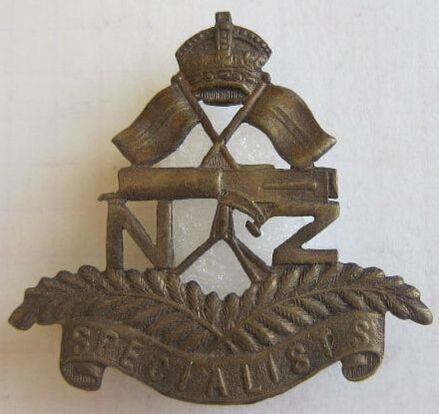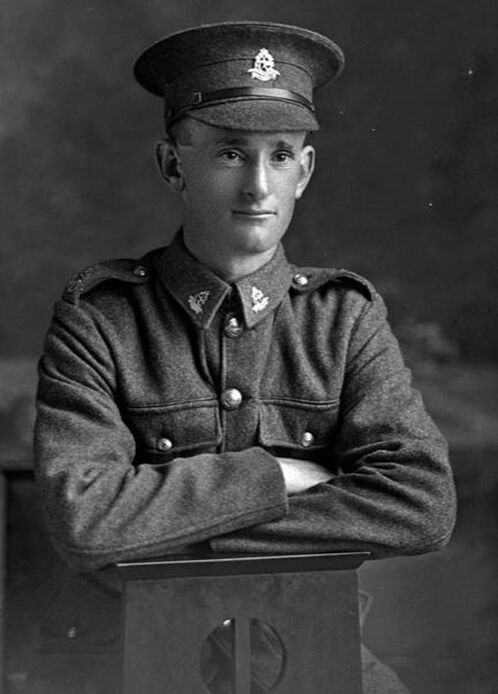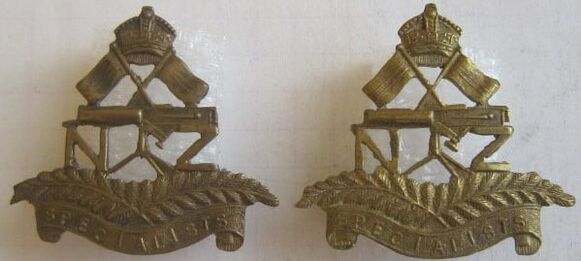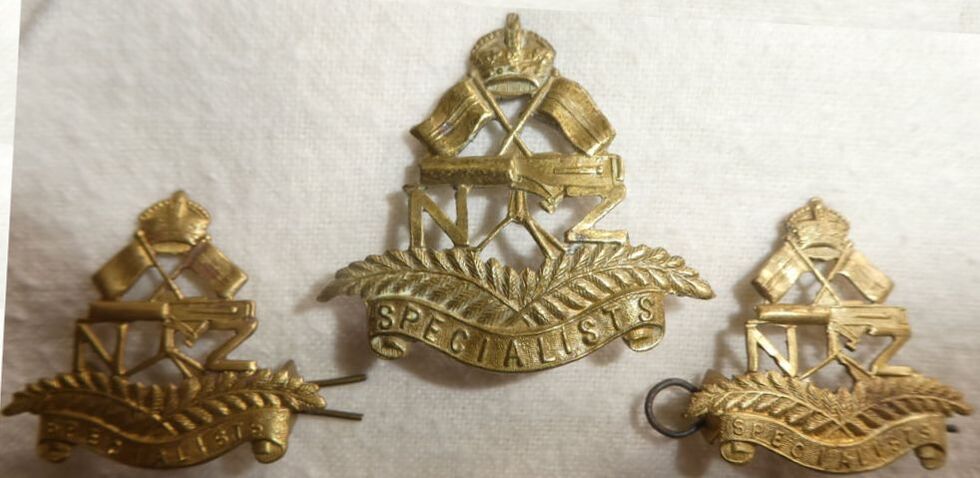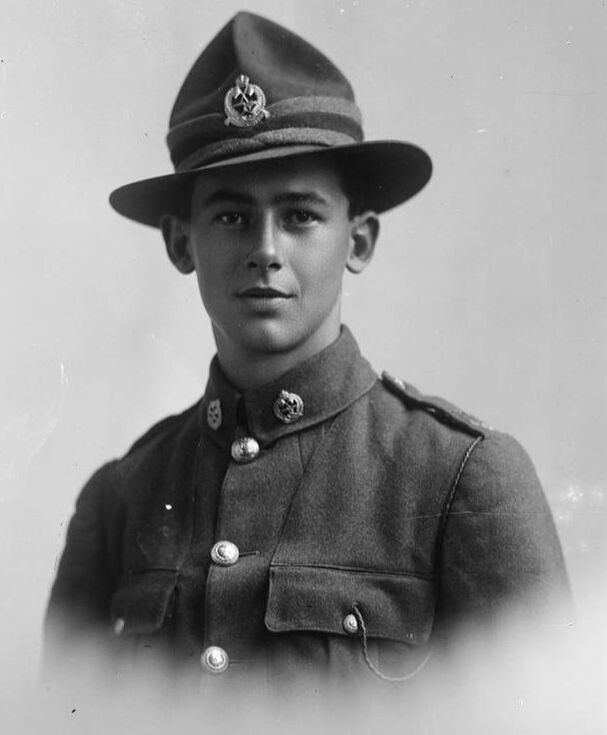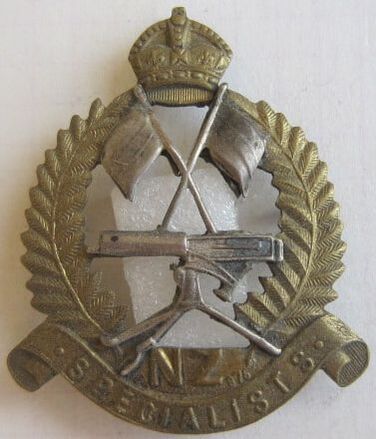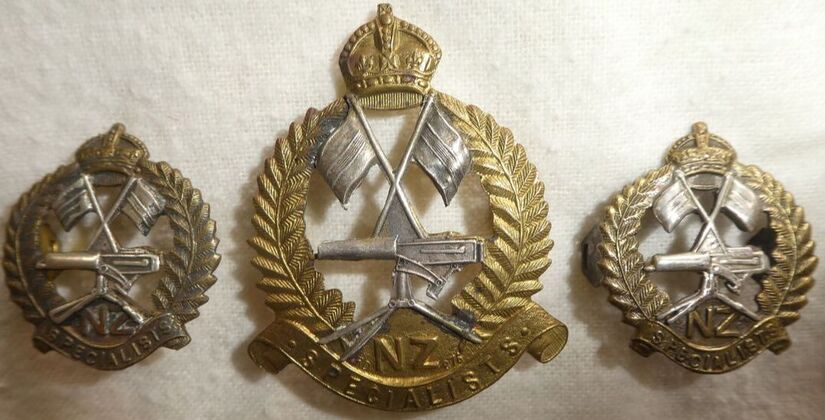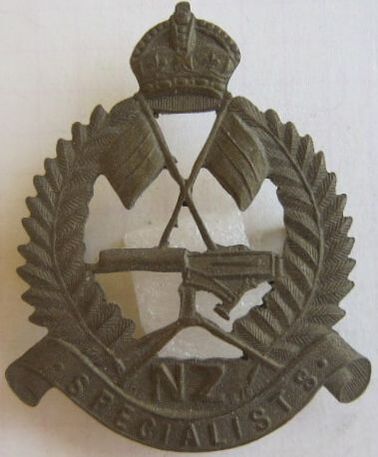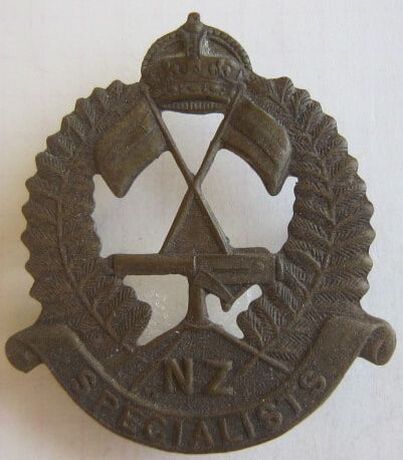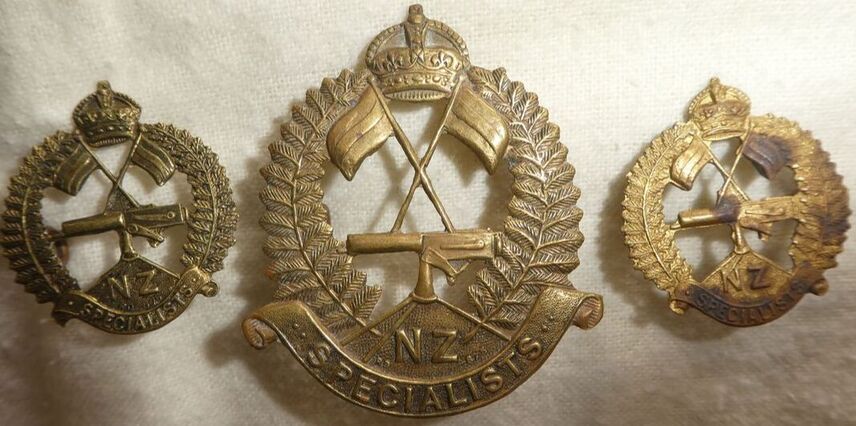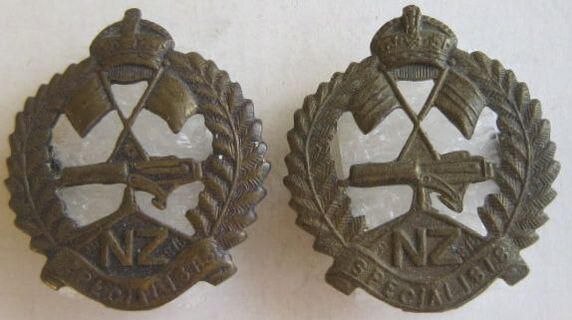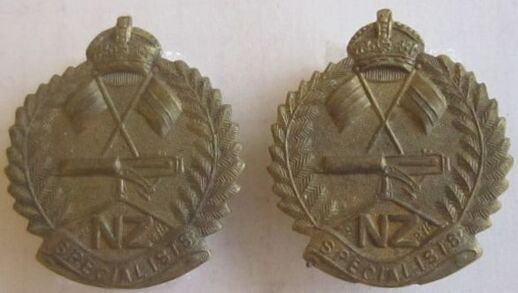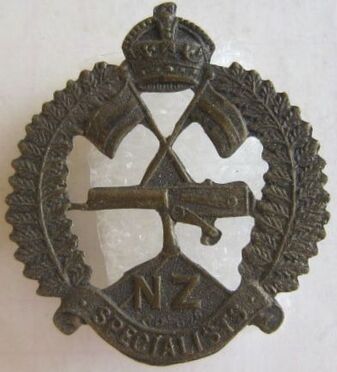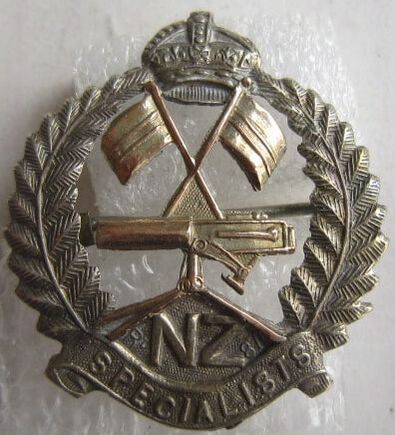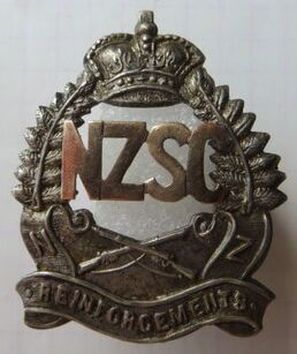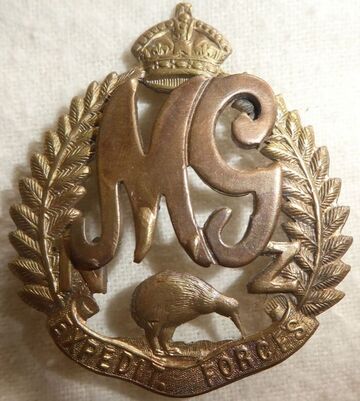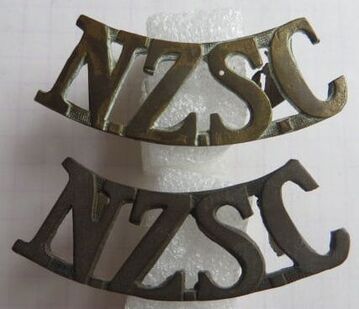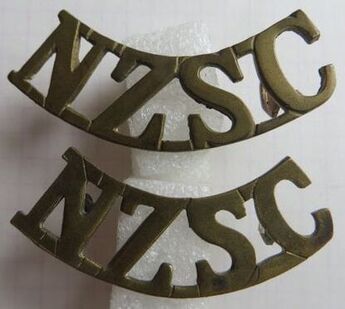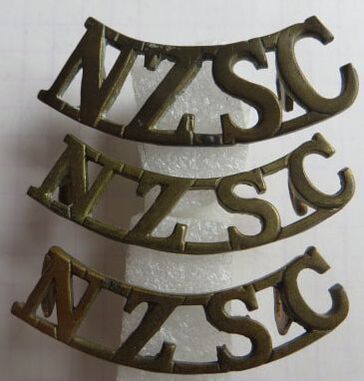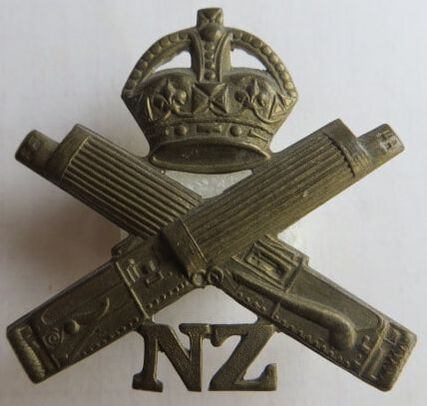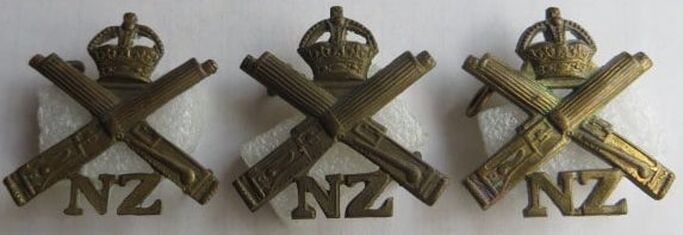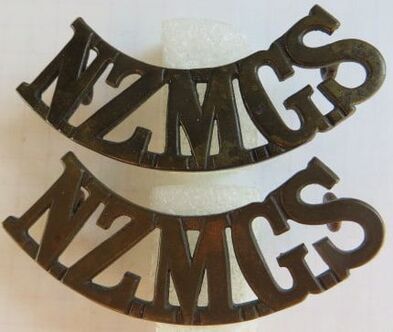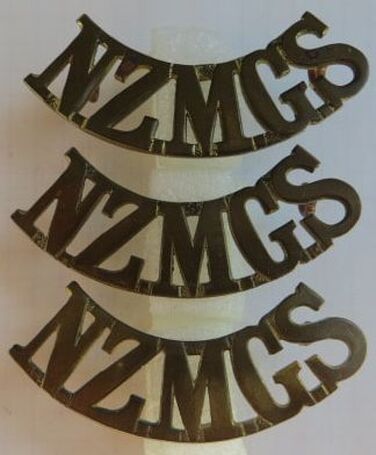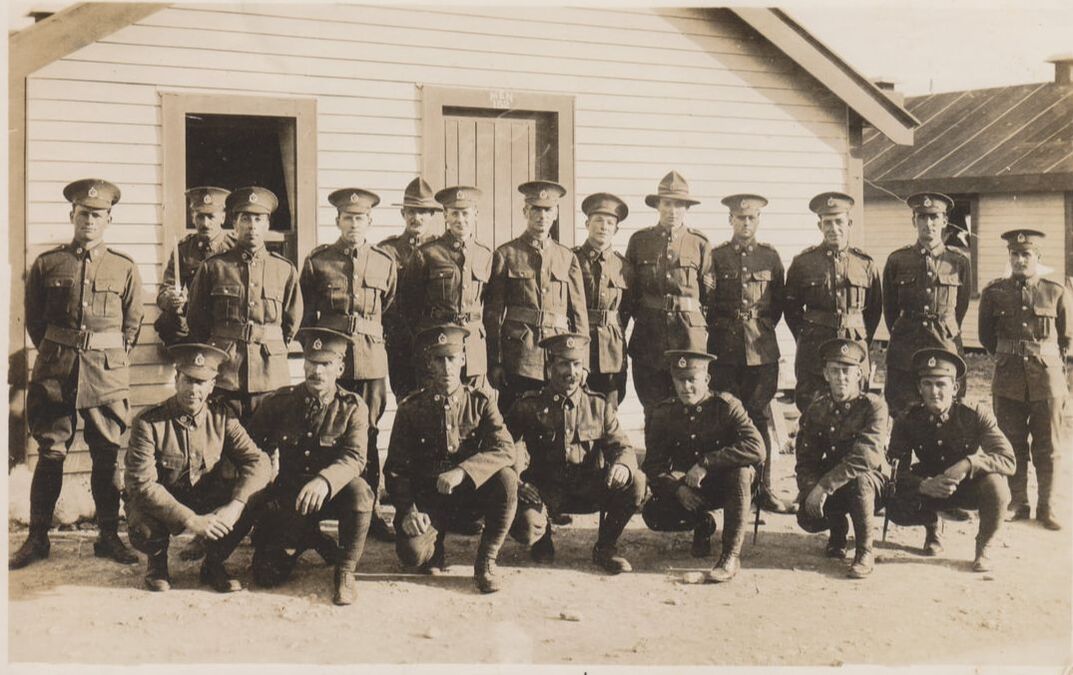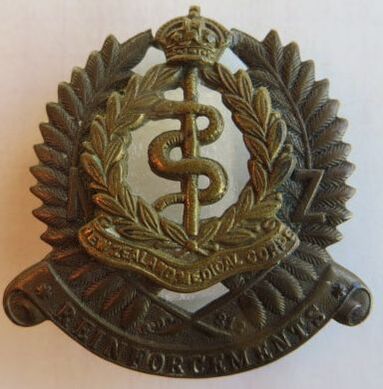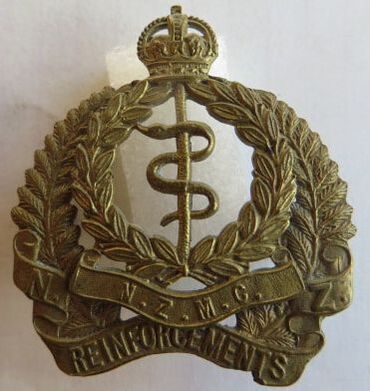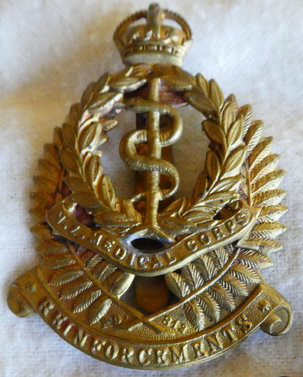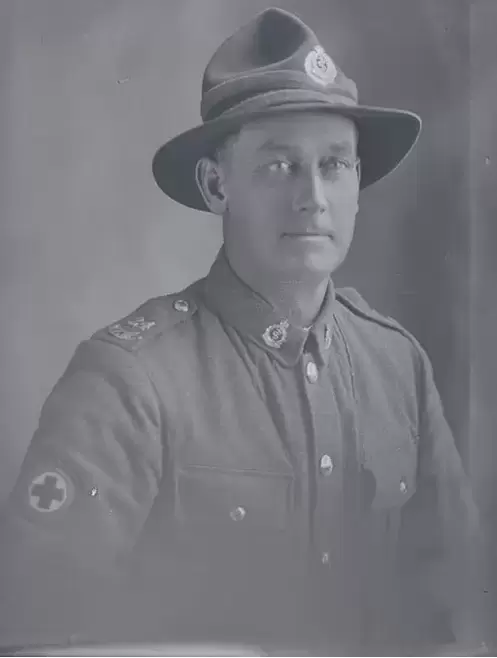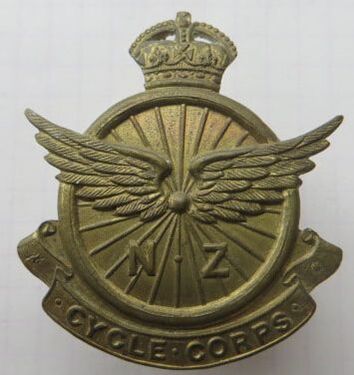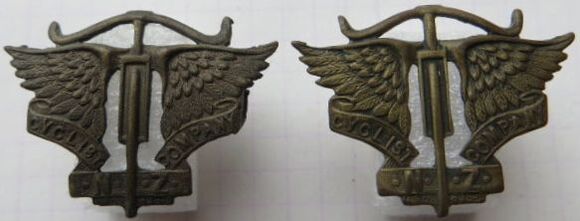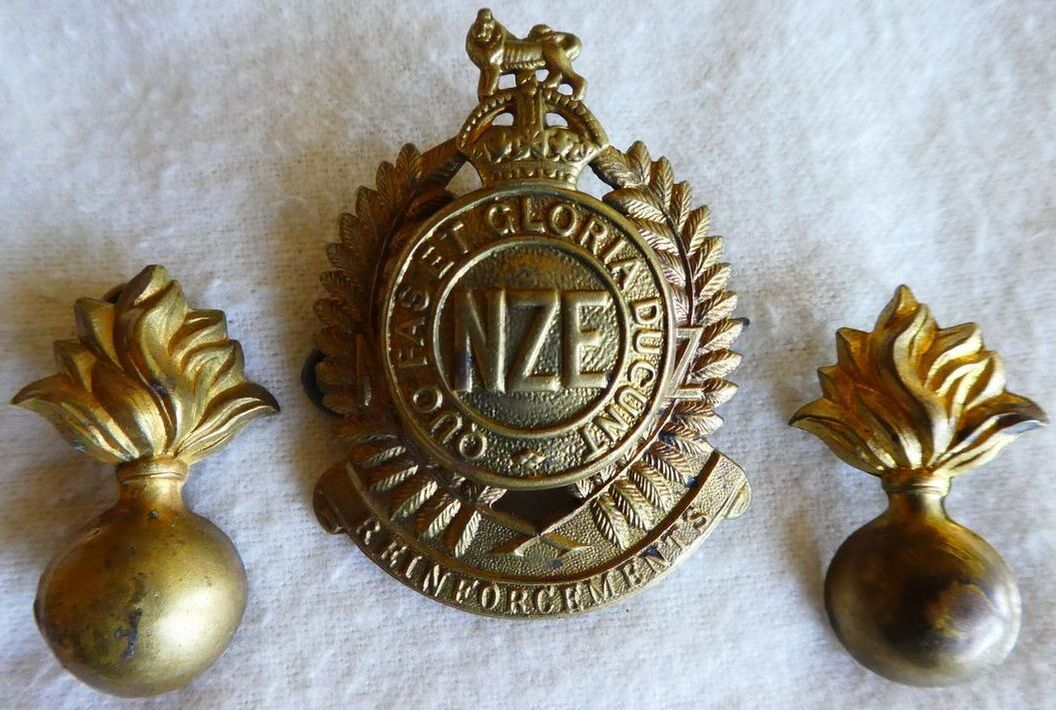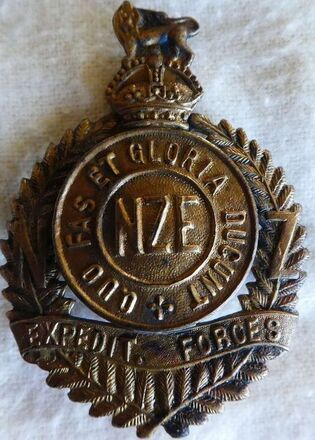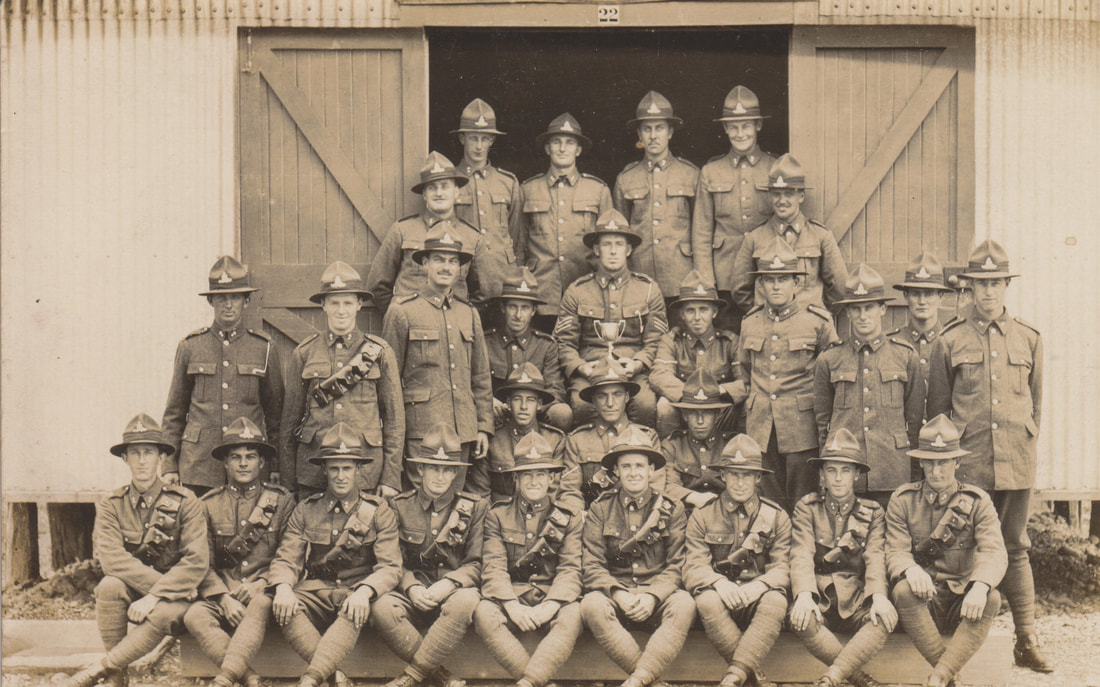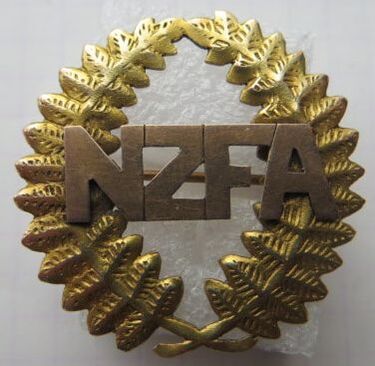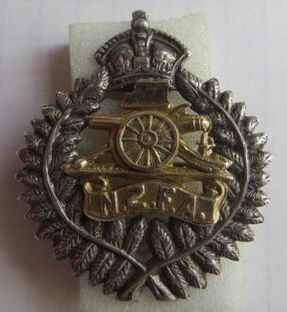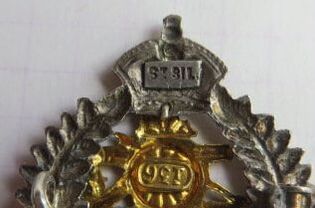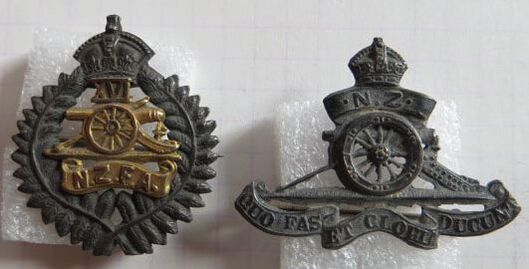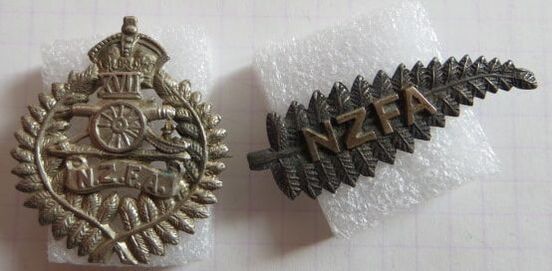New Zealand Specialist Reinforcement Drafts from World War 1
"Specialists" were soldiers who received training outside the three main streams, i.e. not Infantry, Mounted Rifles or New Zealand Rifle Brigade.
I have groups these badges together as they cover New Zealand Artillery, Signalers, Machine Gunners, Medical Corps, Veterinarian Corps, Cyclist Corps, Chaplains and Musicians.
These soldiers were to receive further specialised training in either the UK, or France, and then again when they joined their units.
NZ Machine Gunners received further training at Belton Park, outside Grantham in the UK.
I have groups these badges together as they cover New Zealand Artillery, Signalers, Machine Gunners, Medical Corps, Veterinarian Corps, Cyclist Corps, Chaplains and Musicians.
These soldiers were to receive further specialised training in either the UK, or France, and then again when they joined their units.
NZ Machine Gunners received further training at Belton Park, outside Grantham in the UK.
Specialist Reinforcement
|
- Above: First type - A single piece, gilt brass, generic specialist Reinforcement Cap badge worn by Specialist Reinforcements. It has a pair of hex type brass lugs to back. No maker mark and size 39mm by 41mm.
- Opposite: A image of 40461 Oscar Glen Reston who was part of the 24th Reinforcements, Specialist Company, Signals Section. He started his service on the 14th of Nov 1916, and was eventually to serve in France with the Canterbury Infantry Regiment. He is wearing a set of 1st type Cap and Collar badges, along with a "24" and "NZR" to his shoulder strap (Auckland Cenotaph). |
|
- Above: First type - A matching pair of single piece, gilt brass, generic specialist Reinforcement Collar badges worn by Specialist Reinforcements. Both have a pair of brass, hex type lugs to back, with no maker mark. Size 31mm by 33mm.
|
- Above: A similar First type, generic specialist reinforcement Cap and Collar badge set worn by Specialist Reinforcements (Ian Hamilton Collection).
|
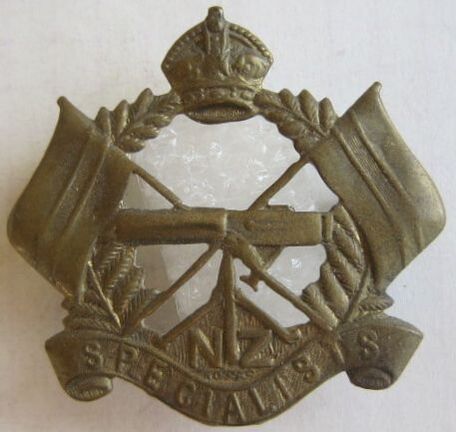
- Opposite: Second Type - A single piece, gilt brass generic specialist reinforcement Cap badge. This doesn't seem to have had any matching Collar badges made with it.
It came in the effects of 1/690 Private John Lecky who commenced his service on the 11th of Aug 1914, and left with the Samoan Expeditionary Force, to capture German held Samoa.
He returned to New Zealand on the 15th of April 1915.
He then re-enlisted on the 25th of July 1916 as part of the 19th Reinforcements, Specialist Company, were he training as part of the NZ Machine Gun Corps.
He then proceeded overseas, to France, where he joined No. 3 Company of the NZMGC but was sadly wounded in action in August 1917, and spent much of the war recovering. He was finally discharged on the 17th of Nov 1919 in New Zealand from Military Hospital.
Note the RD or Registered Design number "RD868" to just under the "NZ" to front.
Two hex type brass lugs to back and size 40mm by 42mm.
RD or Registered Design number 868 was registered to William Henry Haase, 123 Willis Street, Wellington, N.Z. on the 22nd June 1916.
It came in the effects of 1/690 Private John Lecky who commenced his service on the 11th of Aug 1914, and left with the Samoan Expeditionary Force, to capture German held Samoa.
He returned to New Zealand on the 15th of April 1915.
He then re-enlisted on the 25th of July 1916 as part of the 19th Reinforcements, Specialist Company, were he training as part of the NZ Machine Gun Corps.
He then proceeded overseas, to France, where he joined No. 3 Company of the NZMGC but was sadly wounded in action in August 1917, and spent much of the war recovering. He was finally discharged on the 17th of Nov 1919 in New Zealand from Military Hospital.
Note the RD or Registered Design number "RD868" to just under the "NZ" to front.
Two hex type brass lugs to back and size 40mm by 42mm.
RD or Registered Design number 868 was registered to William Henry Haase, 123 Willis Street, Wellington, N.Z. on the 22nd June 1916.
|
- Above: Third type, and the rarer bi-metal Cap badge to the Specialists, with white metal center on a gilt brass frame. Two hex type lugs to back. Note the RD or Registered Design number "RD876" just below the "NZ" to front. Size 50mm by 41mm.
- Opposite: A superb image of a Specialist Reinforcement, wearing the 3rd type of Cap and Collar badges (Auckland Libraries Heritage Collections 7003-058). |
- Above: A similar third type, bi-metal Cap and Collar badge set to the Specialists, with white metal center on a gilt brass frame. Note the RD or Registered Design number "RD876" to front of Cap (Ian Hamilton Collection).
RD or Registered Design number 876 was registered to William Henry Haase (Dental Assistant), 123 Willis Street, Wellington, N.Z. on the 7th of August 1916.
|
- Above: An all gilt brass, 3rd type, single piece Cap badge depicting crossed signal flags over a Machine Gun. Hex brass type lugs to the back. Maker marked to RD or Registered Design number "RD876" to front, below the "NZ". This is the most commonly encountered type. Size 50mm by 41mm.
|
- Above: A scarce all gilt brass 3rd type variation. Note the crown joins mid-way by the fern border, which is much wider than the version to the left. Copper wire looped lugs to the back. Maker marked to RD or Registered Design number "RD875" to front, below the "NZ". Size 49mm by 43mm.
|
- Above: A similar scarce all gilt brass variation, with wide fern border and Collar badges. A maker marked to RD or Registered Design number "RD875" to front, below the "NZ" (Ian Hamilton Collection).
RD or Registered Design number 875 was registered to Arnold Binns (Jewelers), Trentham Military Camp, Trentham N.Z. on the 31st of July 1916.
RD or Registered Design number 876 was registered to William Henry Haase (Dental Assistant), 123 Willis Street, Wellington, N.Z. on the 7th of August 1916.
RD or Registered Design number 876 was registered to William Henry Haase (Dental Assistant), 123 Willis Street, Wellington, N.Z. on the 7th of August 1916.
|
- Above: A matching pair of single piece, 3rd type, gilt brass Collar badges to the Specialist Reinforcement Drafts. Both have 2 brass hex type lugs to back and RD or Registered Design mark "RD876" to either side of "NZ" at base. Size 31mm by 27mm.
|
- Above: A matching pair of single piece, 3rd type, solid gilt brass Collar badges to the Specialist Reinforcement Drafts. Both have 2 brass hex type lugs to back and RD or Registered Design mark "RD876" to either side of "NZ" at base. Size 31mm by 27mm.
|
|
- Above: A variation of single piece, gilt brass Collar badges to the Specialist Reinforcement Drafts. Two copper looped lugs to back and RD or Registered Design mark "RD876" below the "NZ" at base. Note the finer wreath. Size 31mm by 28mm.
|
- Above: A two piece, Copper, with silver overlay to center, Collar badges to the Specialist Reinforcement Drafts. Small hex type lugs to back and RD or Registered Design mark "RD876" to either side of "NZ" at base. Size 31mm by 27mm.
|
- Above: A Sweethearts badge, Collar size in 9ct Gold to center with a Silver frame to the Specialist Reinforcements. Brooch fitting to back, with "Stg Silver" to base of frame and "9ct" to center. RD or Registered Design mark "RD876" to either side of "NZ" at base. Size 30mm by 27mm.
|
RD or Registered Design number 876 was registered to William Henry Haase (Dental Assistant), 123 Willis Street, Wellington, N.Z. on the 7th of August 1916.
|
- Above: A pair of die stamped gilt brass shoulder titles to the New Zealand Specialist Company. Note the stippling between the letters, a feature of Stokes & Son of Melbourne made titles. Thin hex type brass lugs to back and no maker mark. These were sold and worn by Specialists while training in New Zealand.
|
- Opposite Top: A short or narrow die stamped brass shoulder title to the New Zealand Specialist Company. Hex type brass lugs to back, but no maker.
- Opposite : A pair of 10mm high gilt brass shoulder titles to the New Zealand Specialist Company. Slight difference to back, with one having copper looped lugs, while the other has hex type brass lugs. Both are not maker marked.
- Opposite : A pair of 10mm high gilt brass shoulder titles to the New Zealand Specialist Company. Slight difference to back, with one having copper looped lugs, while the other has hex type brass lugs. Both are not maker marked.
|
- Opposite & Above: A Cap and Collars to the New Zealand Machine Gun Section. These have been made in New Zealand and worn by Reinforcements to the unit from the 34th Reinforcements, onwards. They have two thin brass wire looped lugs to back on the top left, and bottom arms of the badge. These are referred to as the "Stubby Barrel" version, just because the barrels on the guns are thicker and shorter than their European made counterparts. No maker mark. Note one Collar and the Cap, have a void beneath the crown.
|
|
- Above: A pair of WW1 reinforcement shoulder titles to the New Zealand Machine Gun Section (N.Z.M.G.S). Worn by Reinforcements in New Zealand while training. Both are marked to "Stokes & Sons" on the "M" to back and both have two copper looped lugs. Note the stippling between the letters to front, which is a feature of this Australian maker.
- Opposite Top & Middle: A matching pair of again WW1 shoulder titles to the New Zealand Machine Gun Section (N.Z.M.G.S). These have a smaller "Stokes & Sons, Melb" stamping to back, which has been overstamped by "Bock Wellington", who maybe on-sold the titles to soldiers in the camps. Stamping is again on the back of the "M". |
- Above Bottom: A single title to the New Zealand Machine Gun Section (N.Z.M.G.S). Not maker marked and with two copper looped lugs to back. Likely Stokes, but just not marked.
|
- Above: A superb image of a group of New Zealand Specialist Reinforcements at Featherston Camp. Nearly all are wearing the 3rd Type Specialist Cap and matching collar badges. Two also clearly have the "NZMGS" shoulder title. I think they also have a "23" on their shoulder boards, but its not as clear. The back of the card is dated "Featherston, 6th Sept. 1917. Dear Alice, Can you pick the dial of yours truly. I wrote to you a couple of days ago, but I believe I put the wrong address on it so if you don't get it please take this as an answer to your last. Kind regards to Mina. Yours truly Leo."
NZ Veterinarian Reinforcements

- Opposite: A scarce 2 piece, Veterinarian Corps reinforcement gilt brass cap badge. I have seen a handful of these over the years of collecting. All appear to be on this frame, but can also be non-void to center, which has the monogram of NZVC or New Zealand Veterinarian Corps. I have never seen any corresponding Collars for this badge.
The main body of the New Zealand Expeditionary Force (NZEF) left New Zealand on the 15th of October 1914.
It contained 3 Veterinary Surgeons (unattached).
Vessels used from Wellington: Maunganui, Tahiti, Ruapehu, Orari, Limerick, Hawke's Bay, Arawa, Athenic - Wellington to Alexandria - 48 days duration.
Vessels used from Auckland: Star of India, Waimana - Auckland to Alexandria - 48 days duration.
The Main Body and 1st Reinforcements also had a Naval escort: HMS Minotaur, HMS Philomel, HMS Psyche, HMS Pyramus & HIJMS Ibuki.
The 2nd Reinforcements left NZ on the 14th of Dec 1914.
It contained:
- 2 Mobile Veterinary Sections - 2 Officers & 26 Other Ranks
- 2 Veterinary Sections - 4 Officers & 226 Other Ranks
Vessels used from Wellington: Verdala, Willochra, Knight of the Garter - Wellington to Suez - 46 days duration.
The 3rd Reinforcements left NZ on the 14th of Feb 1915.
It contained:
- 2 Mobile Veterinary Sections - 2 Other Ranks
- 2 Veterinary Sections - 1 Officer & 23 Other Ranks
Vessels used from Wellington: Maunganui, Tahiti, Aparima - Wellington to Suez - 40 days duration.
The 4th Reinforcements left NZ on the 17th of April 1915.
It contained:
- 2 Veterinary Sections - 1 Officer & 3 Other Ranks
Vessels used from Wellington: Willochra, Knight Templar, Waitomo - Wellington to Suez - 38 days duration.
The 5th Reinforcements left NZ on the 13th of June 1915.
It contained:
- 2 Mobile Veterinary Sections - 4 Other Ranks
- 2 Veterinary Sections - 2 Officers & 10 Other Ranks
Vessels used from Wellington: Maunganui, Tahiti, Aparima - Wellington to Suez - 39 days duration.
The majority of the 6th Reinforcements left NZ on the 11th of Aug 1915.
It contained:
- 2 Mobile Veterinary Sections - 1 Other Ranks
- 2 Veterinary Sections - 11 Other Ranks
Vessels used from Wellington: Willochra and Tofua - Wellington to Suez - 36 days duration.
The 7th Reinforcements left NZ on the 9th of Oct 1915.
It contained:
- 2 Mobile Veterinary Sections - 2 Other Ranks
- 2 Veterinary Sections - 1 Officer & 12 Other Ranks
Vessels used from Wellington: Maunganui, Tahiti, Aparima, Navua and Warrimoo - Wellington to Suez - 36 to 41 days duration.
The 8th Reinforcements left NZ on the 14th of Nov 1915.
It contained:
- 2 Mobile Veterinary Sections - 3 Other Ranks
- 2 Veterinary Sections - 35 Other Ranks
Vessels used from Wellington: Willochra and Tofua - Wellington to Suez - 35 days duration.
The main body of the New Zealand Expeditionary Force (NZEF) left New Zealand on the 15th of October 1914.
It contained 3 Veterinary Surgeons (unattached).
Vessels used from Wellington: Maunganui, Tahiti, Ruapehu, Orari, Limerick, Hawke's Bay, Arawa, Athenic - Wellington to Alexandria - 48 days duration.
Vessels used from Auckland: Star of India, Waimana - Auckland to Alexandria - 48 days duration.
The Main Body and 1st Reinforcements also had a Naval escort: HMS Minotaur, HMS Philomel, HMS Psyche, HMS Pyramus & HIJMS Ibuki.
The 2nd Reinforcements left NZ on the 14th of Dec 1914.
It contained:
- 2 Mobile Veterinary Sections - 2 Officers & 26 Other Ranks
- 2 Veterinary Sections - 4 Officers & 226 Other Ranks
Vessels used from Wellington: Verdala, Willochra, Knight of the Garter - Wellington to Suez - 46 days duration.
The 3rd Reinforcements left NZ on the 14th of Feb 1915.
It contained:
- 2 Mobile Veterinary Sections - 2 Other Ranks
- 2 Veterinary Sections - 1 Officer & 23 Other Ranks
Vessels used from Wellington: Maunganui, Tahiti, Aparima - Wellington to Suez - 40 days duration.
The 4th Reinforcements left NZ on the 17th of April 1915.
It contained:
- 2 Veterinary Sections - 1 Officer & 3 Other Ranks
Vessels used from Wellington: Willochra, Knight Templar, Waitomo - Wellington to Suez - 38 days duration.
The 5th Reinforcements left NZ on the 13th of June 1915.
It contained:
- 2 Mobile Veterinary Sections - 4 Other Ranks
- 2 Veterinary Sections - 2 Officers & 10 Other Ranks
Vessels used from Wellington: Maunganui, Tahiti, Aparima - Wellington to Suez - 39 days duration.
The majority of the 6th Reinforcements left NZ on the 11th of Aug 1915.
It contained:
- 2 Mobile Veterinary Sections - 1 Other Ranks
- 2 Veterinary Sections - 11 Other Ranks
Vessels used from Wellington: Willochra and Tofua - Wellington to Suez - 36 days duration.
The 7th Reinforcements left NZ on the 9th of Oct 1915.
It contained:
- 2 Mobile Veterinary Sections - 2 Other Ranks
- 2 Veterinary Sections - 1 Officer & 12 Other Ranks
Vessels used from Wellington: Maunganui, Tahiti, Aparima, Navua and Warrimoo - Wellington to Suez - 36 to 41 days duration.
The 8th Reinforcements left NZ on the 14th of Nov 1915.
It contained:
- 2 Mobile Veterinary Sections - 3 Other Ranks
- 2 Veterinary Sections - 35 Other Ranks
Vessels used from Wellington: Willochra and Tofua - Wellington to Suez - 35 days duration.
NZ Medical Reinforcements
|
- Above: A 2 piece New Zealand Medical Corps reinforcement cap badge. Large reinforcement frame, which has had its crown cut down and a New Zealand Medical Corps Collar badge sweated onto the front. The lugs of the collar badge have been clipped/cut off. The reinforcement frame has two hex type lugs to back. Size 43mm by 42mm.
|
- Above: A similar 2 piece New Zealand Medical Corps reinforcement cap badge.
Different brass reinforcement frame which has had a N.Z.M.C. solid Collar badge sweated onto the front. The lugs of the Collar badge have again been clipped/cut off. The reinforcement frame has wire copper lugs to back. Size 41mm by 37mm. |
|
- Above: A variation of a New Zealand Medical Corps reinforcement cap badge. Note the banner with a "N.Z. Medical Corps". The badge also appears to still have its slider to back. RD or Registered Design "812" to front on frame (Ian Hamilton Collection).
- Opposite: A superb image of 3/3132 William Thomas Smith, who started his service on the 9th of Jan 1917 as part of the 24th Reinforcements. He was assigned in camp as Acting Sergeant in charge of Sanitary Arrangements. Note his two piece Cap badge, with a NZMC (lower banner unknown) badge sweated onto the front of a Reinforcement frame. He is wearing NZMC Collars to his tunic, a "24" and curved "NZMC" to his shoulder titles. He also has a Geneva Cross patch to his sleeve (Image from the Auckland Cenotaph). |
NZ Cyclist Reinforcements
The NZ Cyclist Corps formed in 1916, with reinforcement drafts beginning to train that year.
|
- Above: A Cap badge to the New Zealand Cycle Corps. This pattern of badge was apparently used prior to WW1 by some New Zealand Volunteer units in the 1902 to 1914 period. Sadly records of who, have been lost. It appears that it was offered as a private purchase badge to NZ Cyclist Reinforcements. It also comes in a rather rare White metal wings on Copper version. Two brass wire looped lugs to back. No maker mark.
- Opposite: A pair of darkened brass Collar badges to the New Zealand Cyclist Reinforcements. Again, both have a RD or Registered Design mark of "RD 838-9" on either side of the tire, under the "N.Z" banner. Two hex type brass lugs to back on each.
|
- Above: The iconic winged bicycle Cap badge in darkened brass. Worn by New Zealand Cyclist Reinforcements. Note the "N.Z. Cyclist Company" banner. It has a RD or Registered Design mark of "RD 838-9" on either side of the tire, under the "N.Z" banner. Two hex type brass lugs to back.
|
RD or Registered Design numbers 838 and 839 were registered to Smith & Sherlaw (Watchmakers & Jewelers), Featherston Military Camp & Levin N.Z. on the 6th of April 1916.
Formed in March 1916 from men intended to be part of the New Zealand Mounted Rifles, the New Zealand Cyclist Company sailed with the 12th Reinforcements.
The 12th Reinforcements left NZ on the 1st and 6th of May 1916.
- Within the draft was the 6 Officers and 212 Other Ranks of the NZCC.
Vessels used from Wellington: Ulimaroa, Mokota and Navua - Wellington to Suez - 40 days duration.
They arrived in France in June 1916, to static warfare and not a mobile situation they were trained for. They spent much of the war behind the lines performing tasks such as controlling traffic, laying cables and repairing trenches.
In early 1918, they were called upon to fight as infantry in the Battle of the Lys (April) and offensive actions in the Second Battle of the Marne (July-August).
Totals sent overseas during WW1 remained 6 Officers and 212 Other Ranks.
Formed in March 1916 from men intended to be part of the New Zealand Mounted Rifles, the New Zealand Cyclist Company sailed with the 12th Reinforcements.
The 12th Reinforcements left NZ on the 1st and 6th of May 1916.
- Within the draft was the 6 Officers and 212 Other Ranks of the NZCC.
Vessels used from Wellington: Ulimaroa, Mokota and Navua - Wellington to Suez - 40 days duration.
They arrived in France in June 1916, to static warfare and not a mobile situation they were trained for. They spent much of the war behind the lines performing tasks such as controlling traffic, laying cables and repairing trenches.
In early 1918, they were called upon to fight as infantry in the Battle of the Lys (April) and offensive actions in the Second Battle of the Marne (July-August).
Totals sent overseas during WW1 remained 6 Officers and 212 Other Ranks.
New Zealand Engineer Reinforcements
|
- Above: A New Zealand Engineers reinforcement set, with two piece Cap badge to center, with a NZE Cap badge sweated onto a convex reinforcement frame. Either side are the standard New Zealand Engineers (and NZFA) Collar badge, which was also worn by its reinforcements (Ian Hamilton Collection).
|
- Above: A two piece New Zealand Engineers reinforcement Cap badge, on a scarcer frame type with the words "Expedit. Forces" on lower banner (Ian Hamilton Collection).
|
NZ Army Ordnance Reinforcements
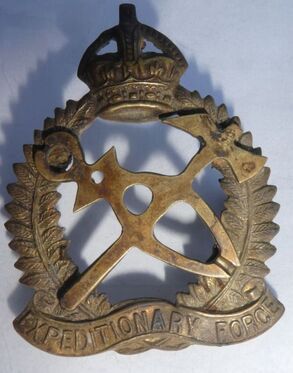
- Opposite: A rare and unusual Reinforcements Cap badge to a Artificer, which I presume is associated with the New Zealand Army Ordnance Corps during WW1. To center is a Artificer badge or Pincer and Hammer, sweated to the front of a 34th and beyond Reinforcement Cap badge (Ian Hamilton Collection).
NZ Field Artillery Reinforcements
The New Zealand Field Artillery had their own Reinforcement drafts during WW1. Being a private purchase item, their badge could have been any of the badges which have been covered in the Infantry Reinforcement section on the website. From pictures taken at the time, it looks likely that they wore the standard New Zealand Artillery Cap badge (NZ to top scroll) and the small flaming grenade Collar badges.
Some of the Sweetheart badges do though record the draft numbers.
Some of the Sweetheart badges do though record the draft numbers.
- Above: A group of New Zealand Field Artillery Reinforcements, in Camp. The Sergeant to the center is likely holding a competition cup for turnout of the barracks hut behind. Sadly not named or with location or indicating the draft number it shows. Note all men have a NZA Cap badge with flaming grenade collar badges. They also have metal shoulder titles, which I sadly can't make out, but presume say "NZFA".
The main body of the New Zealand Expeditionary Force (NZEF) left New Zealand on the 15th of October 1914.
In terms of Artillery, it consisted of:
Divisional Artillery made up of:
No. 1 Field Artillery Brigade:
- Headquarters - 5 Officers & 38 Other Ranks
- No. 1 Field Battery - 5 Officers & 141 Other Ranks
- No. 2 Field Battery - 5 Officers & 141 Other Ranks
- No. 3 Field Battery - 5 Officers & 141 Other Ranks
- No. 1 Brigade Ammunition Column - 3 Officers & 131 Other Ranks
The 1st Reinforcements left with the main body of the New Zealand Expeditionary Force (NZEF) on the 15th of October 1914.
It contained:
No. 1 Field Artillery Brigade:
- 1 Officer
- Headquarters - 5 Other Ranks
- No. 1 Field Battery - 16 Other Ranks
- No. 2 Field Battery - 16 Other Ranks
- No. 3 Field Battery - 16 Other Ranks
- No. 1 Brigade Ammunition Column - 13 Other Ranks
Vessels used from Wellington: Maunganui, Tahiti, Ruapehu, Orari, Limerick, Hawke's Bay, Arawa, Athenic - Wellington to Alexandria - 48 days duration.
Vessels used from Auckland: Star of India, Waimana - Auckland to Alexandria - 48 days duration.
The Main Body and 1st Reinforcements also had a Naval escort: HMS Minotaur, HMS Philomel, HMS Psyche, HMS Pyramus & HIJMS Ibuki.
The 2nd Reinforcements left NZ on the 14th of Dec 1914.
No. 1 Field Artillery Brigade:
- 3 Officers
- Headquarters - 7 Other Ranks
- No. 1 Field Battery - 28 Other Ranks
- No. 2 Field Battery - 28 Other Ranks
- No. 3 Field Battery - 28 Other Ranks
- No. 1 Brigade Ammunition Column - 26 Other Ranks
No. 2 Field Artillery Brigade:
- No. 4 (Howitzer) Battery - 6 Officers & 154 Other Ranks
Vessels used from Wellington: Verdala, Willochra, Knight of the Garter - Wellington to Suez - 46 days duration.
The 3rd Reinforcements left NZ on the 14th of Feb 1915.
No. 2 Field Artillery Brigade:
- No. 4 (Howitzer) Battery - 1 Officer & 36 Other Ranks
Vessels used from Wellington: Maunganui, Tahiti, Aparima - Wellington to Suez - 40 days duration.
The 4th Reinforcements left NZ on the 17th of April 1915.
No. 1 Field Artillery Brigade:
- 1 Officer
- No. 1 Field Battery - 23 Other Ranks
- No. 2 Field Battery - 23 Other Ranks
- No. 3 Field Battery - 23 Other Ranks
- No. 1 Brigade Ammunition Column - 19 Other Ranks
No. 2 Field Artillery Brigade:
- No. 4 (Howitzer) Battery - 1 Officer & 36 Other Ranks
- No. 5 Field Battery - 5 Officers & 155 Other Ranks
Vessels used from Wellington: Willochra, Knight Templar, Waitomo - Wellington to Suez - 38 days duration.
In terms of Artillery, it consisted of:
Divisional Artillery made up of:
No. 1 Field Artillery Brigade:
- Headquarters - 5 Officers & 38 Other Ranks
- No. 1 Field Battery - 5 Officers & 141 Other Ranks
- No. 2 Field Battery - 5 Officers & 141 Other Ranks
- No. 3 Field Battery - 5 Officers & 141 Other Ranks
- No. 1 Brigade Ammunition Column - 3 Officers & 131 Other Ranks
The 1st Reinforcements left with the main body of the New Zealand Expeditionary Force (NZEF) on the 15th of October 1914.
It contained:
No. 1 Field Artillery Brigade:
- 1 Officer
- Headquarters - 5 Other Ranks
- No. 1 Field Battery - 16 Other Ranks
- No. 2 Field Battery - 16 Other Ranks
- No. 3 Field Battery - 16 Other Ranks
- No. 1 Brigade Ammunition Column - 13 Other Ranks
Vessels used from Wellington: Maunganui, Tahiti, Ruapehu, Orari, Limerick, Hawke's Bay, Arawa, Athenic - Wellington to Alexandria - 48 days duration.
Vessels used from Auckland: Star of India, Waimana - Auckland to Alexandria - 48 days duration.
The Main Body and 1st Reinforcements also had a Naval escort: HMS Minotaur, HMS Philomel, HMS Psyche, HMS Pyramus & HIJMS Ibuki.
The 2nd Reinforcements left NZ on the 14th of Dec 1914.
No. 1 Field Artillery Brigade:
- 3 Officers
- Headquarters - 7 Other Ranks
- No. 1 Field Battery - 28 Other Ranks
- No. 2 Field Battery - 28 Other Ranks
- No. 3 Field Battery - 28 Other Ranks
- No. 1 Brigade Ammunition Column - 26 Other Ranks
No. 2 Field Artillery Brigade:
- No. 4 (Howitzer) Battery - 6 Officers & 154 Other Ranks
Vessels used from Wellington: Verdala, Willochra, Knight of the Garter - Wellington to Suez - 46 days duration.
The 3rd Reinforcements left NZ on the 14th of Feb 1915.
No. 2 Field Artillery Brigade:
- No. 4 (Howitzer) Battery - 1 Officer & 36 Other Ranks
Vessels used from Wellington: Maunganui, Tahiti, Aparima - Wellington to Suez - 40 days duration.
The 4th Reinforcements left NZ on the 17th of April 1915.
No. 1 Field Artillery Brigade:
- 1 Officer
- No. 1 Field Battery - 23 Other Ranks
- No. 2 Field Battery - 23 Other Ranks
- No. 3 Field Battery - 23 Other Ranks
- No. 1 Brigade Ammunition Column - 19 Other Ranks
No. 2 Field Artillery Brigade:
- No. 4 (Howitzer) Battery - 1 Officer & 36 Other Ranks
- No. 5 Field Battery - 5 Officers & 155 Other Ranks
Vessels used from Wellington: Willochra, Knight Templar, Waitomo - Wellington to Suez - 38 days duration.
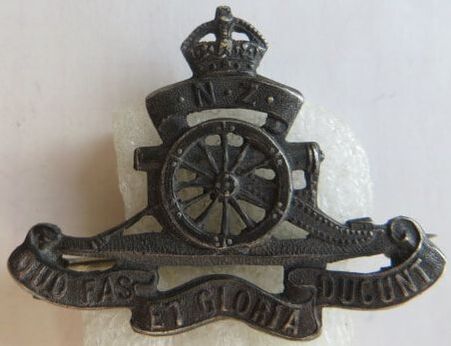
The 5th Reinforcements left NZ on the 13th of June 1915.
No. 1 Field Artillery Brigade:
- 1 Officer
- Headquarters - 6 Other Ranks
- No. 1 Field Battery - 20 Other Ranks
- No. 2 Field Battery - 20 Other Ranks
- No. 3 Field Battery - 20 Other Ranks
- No. 1 Brigade Ammunition Column - 20 Other Ranks
No. 2 Field Artillery Brigade:
- Headquarters - 1 Officer & 42 Other Ranks
- No. 5 Field Battery - 1 Officer & 29 Other Ranks
- No. 6 (Howitzer) Battery - 5 Officer & 155 Other Ranks
- (A) Howitzer Battery Ammunition Column (Egypt) - 24 Other Ranks
- (B) Howitzer Battery Ammunition Column (for No. 6 (Howitzer) Battery) - 1 Officer & 44 Other Ranks
Vessels used from Wellington: Maunganui, Tahiti, Aparima - Wellington to Suez - 39 days duration.
- Above: A small, silver sweethearts badge to the New Zealand Artillery. Likely a WW1 example, it has a brooch fitting to lower back badge and is stamped "Stg. Sil" to back of wheel rim. Size 32mm by 40mm.
No. 1 Field Artillery Brigade:
- 1 Officer
- Headquarters - 6 Other Ranks
- No. 1 Field Battery - 20 Other Ranks
- No. 2 Field Battery - 20 Other Ranks
- No. 3 Field Battery - 20 Other Ranks
- No. 1 Brigade Ammunition Column - 20 Other Ranks
No. 2 Field Artillery Brigade:
- Headquarters - 1 Officer & 42 Other Ranks
- No. 5 Field Battery - 1 Officer & 29 Other Ranks
- No. 6 (Howitzer) Battery - 5 Officer & 155 Other Ranks
- (A) Howitzer Battery Ammunition Column (Egypt) - 24 Other Ranks
- (B) Howitzer Battery Ammunition Column (for No. 6 (Howitzer) Battery) - 1 Officer & 44 Other Ranks
Vessels used from Wellington: Maunganui, Tahiti, Aparima - Wellington to Suez - 39 days duration.
- Above: A small, silver sweethearts badge to the New Zealand Artillery. Likely a WW1 example, it has a brooch fitting to lower back badge and is stamped "Stg. Sil" to back of wheel rim. Size 32mm by 40mm.
The majority of the 6th Reinforcements left NZ on the 11th of Aug 1915.
No. 2 Field Artillery Brigade:
- Headquarters - 8 Other Ranks
- No. 5 Field Battery - 2 Officer & 14 Other Ranks
- No. 6 (Howitzer) Battery - 29 Other Ranks
- (B) Howitzer Battery Ammunition Column (for No. 6 (Howitzer) Battery) - 8 Other Ranks
Vessels used from Wellington: Willochra and Tofua - Wellington to Suez - 36 days duration.
The 7th Reinforcements left NZ on the 9th of Oct 1915.
- No. 6 (Howitzer) Battery - 16 Other Ranks
- Divisional Ammunition Column (Egypt) - 5 Officers & 256 Other Ranks
- (B) Howitzer Battery Ammunition Column (for No. 6 (Howitzer) Battery) - 4 Other Ranks
Vessels used from Wellington: Maunganui, Tahiti, Aparima, Navua and Warrimoo - Wellington to Suez - 36 to 41 days duration.
The 8th Reinforcements left NZ on the 14th of Nov 1915.
No. 1 Field Artillery Brigade:
- 1 Officer
- Headquarters - 6 Other Ranks
- No. 1 Field Battery - 21 Other Ranks
- No. 2 Field Battery - 21 Other Ranks
- No. 3 Field Battery - 21 Other Ranks
- No. 1 Brigade Ammunition Column - 20 Other Ranks
No. 2 Field Artillery Brigade:
- 2 Officers
- Headquarters - 6 Other Ranks
- No. 4 (Howitzer) Battery - 21 Other Ranks
- No. 5 Field Battery - 28 Other Ranks
- No. 6 (Howitzer) Battery - 28 Other Ranks
- Divisional Ammunition Column (Egypt) - 47 Other Ranks
- (B) Howitzer Battery Ammunition Column (for No. 6 (Howitzer) Battery) - 8 Other Ranks
Vessels used from Wellington: Willochra and Tofua - Wellington to Suez - 35 days duration.
The 9th Reinforcements left NZ on the 9th of Jan 1916.
No. 1 Field Artillery Brigade:
- 2 Officers
- Headquarters - 5 Other Ranks
- No. 1 Field Battery - 21 Other Ranks
- No. 2 Field Battery - 21 Other Ranks
- No. 3 Field Battery - 21 Other Ranks
- No. 1 Brigade Ammunition Column - 20 Other Ranks
No. 2 Field Artillery Brigade:
- 1 Officer
- Headquarters - 5 Other Ranks
- No. 4 (Howitzer) Battery - 5 Other Ranks
- Divisional Ammunition Column (Egypt) - 35 Other Ranks
- (A) Howitzer Battery Ammunition Column (Egypt) - 6 Other Ranks
- No. 2 Brigade Ammunition Column (Egypt) - 7 Other Ranks
- No. 3 Brigade Ammunition Column (Egypt) - 10 Other Ranks
Vessels used from Wellington: Maunganui, Tahiti and Warrimoo - Wellington to Suez - 29 to 32 days duration.
Horse Transport "Waihora" sailed on the 22nd of Feb with a grouped lot of Divisional Artillery Reinforcements, their specific units were not recorded.
- 1 Officers & 61 Other Ranks
The 10th Reinforcements left NZ on the 11th of Mar 1916.
No. 1 Field Artillery Brigade:
- 1 Officers
- Headquarters - 2 Other Ranks
- No. 1 Field Battery - 10 Other Ranks
- No. 2 Field Battery - 10 Other Ranks
- No. 3 Field Battery - 10 Other Ranks
- No. 1 Brigade Ammunition Column - 7 Other Ranks
No. 2 Field Artillery Brigade:
- 2 Officer
- Headquarters - 2 Other Ranks
- No. 4 (Howitzer) Battery - 10 Other Ranks
- No. 5 Field Battery - 10 Other Ranks
- No. 6 (Howitzer) Battery - 10 Other Ranks
- Divisional Ammunition Column (Egypt) - 10 Other Ranks
- (A) Howitzer Battery Ammunition Column (Egypt) - 4 Other Ranks
- (B) Howitzer Battery Ammunition Column (for No. 6 (Howitzer) Battery) - 4 Other Ranks
- No. 2 Brigade Ammunition Column (Egypt) - 7 Other Ranks
- No. 3 Brigade Ammunition Column (Egypt) - 7 Other Ranks
Vessels used from Wellington: Willochra and Tofua - Wellington to Suez - 35 days duration.
No. 2 Field Artillery Brigade:
- Headquarters - 8 Other Ranks
- No. 5 Field Battery - 2 Officer & 14 Other Ranks
- No. 6 (Howitzer) Battery - 29 Other Ranks
- (B) Howitzer Battery Ammunition Column (for No. 6 (Howitzer) Battery) - 8 Other Ranks
Vessels used from Wellington: Willochra and Tofua - Wellington to Suez - 36 days duration.
The 7th Reinforcements left NZ on the 9th of Oct 1915.
- No. 6 (Howitzer) Battery - 16 Other Ranks
- Divisional Ammunition Column (Egypt) - 5 Officers & 256 Other Ranks
- (B) Howitzer Battery Ammunition Column (for No. 6 (Howitzer) Battery) - 4 Other Ranks
Vessels used from Wellington: Maunganui, Tahiti, Aparima, Navua and Warrimoo - Wellington to Suez - 36 to 41 days duration.
The 8th Reinforcements left NZ on the 14th of Nov 1915.
No. 1 Field Artillery Brigade:
- 1 Officer
- Headquarters - 6 Other Ranks
- No. 1 Field Battery - 21 Other Ranks
- No. 2 Field Battery - 21 Other Ranks
- No. 3 Field Battery - 21 Other Ranks
- No. 1 Brigade Ammunition Column - 20 Other Ranks
No. 2 Field Artillery Brigade:
- 2 Officers
- Headquarters - 6 Other Ranks
- No. 4 (Howitzer) Battery - 21 Other Ranks
- No. 5 Field Battery - 28 Other Ranks
- No. 6 (Howitzer) Battery - 28 Other Ranks
- Divisional Ammunition Column (Egypt) - 47 Other Ranks
- (B) Howitzer Battery Ammunition Column (for No. 6 (Howitzer) Battery) - 8 Other Ranks
Vessels used from Wellington: Willochra and Tofua - Wellington to Suez - 35 days duration.
The 9th Reinforcements left NZ on the 9th of Jan 1916.
No. 1 Field Artillery Brigade:
- 2 Officers
- Headquarters - 5 Other Ranks
- No. 1 Field Battery - 21 Other Ranks
- No. 2 Field Battery - 21 Other Ranks
- No. 3 Field Battery - 21 Other Ranks
- No. 1 Brigade Ammunition Column - 20 Other Ranks
No. 2 Field Artillery Brigade:
- 1 Officer
- Headquarters - 5 Other Ranks
- No. 4 (Howitzer) Battery - 5 Other Ranks
- Divisional Ammunition Column (Egypt) - 35 Other Ranks
- (A) Howitzer Battery Ammunition Column (Egypt) - 6 Other Ranks
- No. 2 Brigade Ammunition Column (Egypt) - 7 Other Ranks
- No. 3 Brigade Ammunition Column (Egypt) - 10 Other Ranks
Vessels used from Wellington: Maunganui, Tahiti and Warrimoo - Wellington to Suez - 29 to 32 days duration.
Horse Transport "Waihora" sailed on the 22nd of Feb with a grouped lot of Divisional Artillery Reinforcements, their specific units were not recorded.
- 1 Officers & 61 Other Ranks
The 10th Reinforcements left NZ on the 11th of Mar 1916.
No. 1 Field Artillery Brigade:
- 1 Officers
- Headquarters - 2 Other Ranks
- No. 1 Field Battery - 10 Other Ranks
- No. 2 Field Battery - 10 Other Ranks
- No. 3 Field Battery - 10 Other Ranks
- No. 1 Brigade Ammunition Column - 7 Other Ranks
No. 2 Field Artillery Brigade:
- 2 Officer
- Headquarters - 2 Other Ranks
- No. 4 (Howitzer) Battery - 10 Other Ranks
- No. 5 Field Battery - 10 Other Ranks
- No. 6 (Howitzer) Battery - 10 Other Ranks
- Divisional Ammunition Column (Egypt) - 10 Other Ranks
- (A) Howitzer Battery Ammunition Column (Egypt) - 4 Other Ranks
- (B) Howitzer Battery Ammunition Column (for No. 6 (Howitzer) Battery) - 4 Other Ranks
- No. 2 Brigade Ammunition Column (Egypt) - 7 Other Ranks
- No. 3 Brigade Ammunition Column (Egypt) - 7 Other Ranks
Vessels used from Wellington: Willochra and Tofua - Wellington to Suez - 35 days duration.
|
- Above: A Gold and gilt brass sweethearts badge to the New Zealand Field Artillery. Marked "9Ct" to back of center, it has a brooch fitting to back.
|
- Above: Another generic type of New Zealand Field Artillery Sweethearts Badge. Gold to center on a silver frame.
|
- Above: Some of these badges are superbly marked. Here is the back of the opposite badge, with two separate small plaques, "St Sil" for Sterling Silver on the frame, and "9ct" for 9 Carat gold to back of center. Brooch fitting to back.
|
The 11th Reinforcements left NZ on the 2nd of April 1916.
No. 1 Field Artillery Brigade:
- 2 Officers
- Headquarters - 3 Other Ranks
- No. 1 Field Battery - 15 Other Ranks
- No. 2 Field Battery - 18 Other Ranks
- No. 3 Field Battery - 16 Other Ranks
- No. 1 Brigade Ammunition Column - 12 Other Ranks
No. 2 Field Artillery Brigade:
- 2 Officer
- Headquarters - 3 Other Ranks
- No. 4 (Howitzer) Battery - 16 Other Ranks
- No. 5 Field Battery - 16 Other Ranks
- No. 6 (Howitzer) Battery - 15 Other Ranks
- Divisional Ammunition Column (Egypt) - 21 Other Ranks
- (A) Howitzer Battery Ammunition Column (Egypt) - 6 Other Ranks
- (B) Howitzer Battery Ammunition Column (for No. 6 (Howitzer) Battery) - 6 Other Ranks
- No. 2 Brigade Ammunition Column (Egypt) - 8 Other Ranks
- No. 3 Brigade Ammunition Column (Egypt) - 9 Other Ranks
Vessels used from Wellington: Maunganui and Tahiti - Wellington to Suez - 35 days duration.
The 12th Reinforcements left NZ on the 1st and 6th of May 1916.
No. 1 Field Artillery Brigade:
- 2 Officers
- Headquarters - 3 Other Ranks
- No. 1 Field Battery - 16 Other Ranks
- No. 2 Field Battery - 16 Other Ranks
- No. 3 Field Battery - 16 Other Ranks
- No. 1 Brigade Ammunition Column - 12 Other Ranks
No. 2 Field Artillery Brigade:
- 1 Officer
- Headquarters - 3 Other Ranks
- No. 4 (Howitzer) Battery - 16 Other Ranks
- No. 5 Field Battery - 16 Other Ranks
- No. 6 (Howitzer) Battery - 16 Other Ranks
- Divisional Ammunition Column (Egypt) - 21 Other Ranks
- (A) Howitzer Battery Ammunition Column (Egypt) - 6 Other Ranks
- (B) Howitzer Battery Ammunition Column (for No. 6 (Howitzer) Battery) - 6 Other Ranks
- No. 2 Brigade Ammunition Column (Egypt) - 8 Other Ranks
- No. 3 Brigade Ammunition Column (Egypt) - 9 Other Ranks
Vessels used from Wellington: Ulimaroa, Mokota and Navua - Wellington to Suez - 40 days duration.
From the 13th Reinforcements onwards, the figures for the drafts are not broken down, but given in just one large, group figure, for the New Zealand Divisional Artillery. At the time, the ANZAC and New Zealand Divisions also moved to France prior to the 13th Reinforcement Draft. The 13th were at sea, and their route changed while on route, so there was no longer a requirement to stop at Suez and Egypt. The Mounted Rifle Reinforcements now arrived on separate transports, often via Australia and then onwards from Australia on a Australian transports.
The 13th Reinforcements left NZ on the 27th of May 1916.
- The 13th Draft contained 4 Officers and 163 Other Ranks of the NZFA.
Vessels used from Wellington: Willochra and Tofua via Cape Good Hope - to Plymouth - 58 days duration.
The 14th Reinforcements left NZ on the 26th of June 1916.
- The 14th Draft contained 3 Officers and 167 Other Ranks of the NZFA.
Vessels used from Wellington: Maunganui and Tahiti via Cape Good Hope - to Plymouth - 59 days duration.
The 15th Reinforcements left NZ on the 26th & 29th of July 1916.
- The 15th Draft contained 3 Officers and 161 Other Ranks of the NZFA.
Vessels used from Wellington: Waitemata and Ulimaroa via Cape Good Hope - to Plymouth - 66 days duration.
The 16th Reinforcements left NZ on the 20th & 25th of Aug 1916.
- The 16th Draft contained 2 Officers and 94 Other Ranks of the NZFA.
Vessels used from Wellington: Aparima, Mokota & Navua via Cape Good Hope - to Newport - 72 days duration.
The 17th Reinforcements left NZ on the 24th & 26th of Sept 1916.
- The 17th Draft contained 2 Officers and 94 Other Ranks of the NZFA.
Vessels used from Wellington: Devon and Pakeha via Cape Good Hope - to Plymouth - 58 days duration.
No. 1 Field Artillery Brigade:
- 2 Officers
- Headquarters - 3 Other Ranks
- No. 1 Field Battery - 15 Other Ranks
- No. 2 Field Battery - 18 Other Ranks
- No. 3 Field Battery - 16 Other Ranks
- No. 1 Brigade Ammunition Column - 12 Other Ranks
No. 2 Field Artillery Brigade:
- 2 Officer
- Headquarters - 3 Other Ranks
- No. 4 (Howitzer) Battery - 16 Other Ranks
- No. 5 Field Battery - 16 Other Ranks
- No. 6 (Howitzer) Battery - 15 Other Ranks
- Divisional Ammunition Column (Egypt) - 21 Other Ranks
- (A) Howitzer Battery Ammunition Column (Egypt) - 6 Other Ranks
- (B) Howitzer Battery Ammunition Column (for No. 6 (Howitzer) Battery) - 6 Other Ranks
- No. 2 Brigade Ammunition Column (Egypt) - 8 Other Ranks
- No. 3 Brigade Ammunition Column (Egypt) - 9 Other Ranks
Vessels used from Wellington: Maunganui and Tahiti - Wellington to Suez - 35 days duration.
The 12th Reinforcements left NZ on the 1st and 6th of May 1916.
No. 1 Field Artillery Brigade:
- 2 Officers
- Headquarters - 3 Other Ranks
- No. 1 Field Battery - 16 Other Ranks
- No. 2 Field Battery - 16 Other Ranks
- No. 3 Field Battery - 16 Other Ranks
- No. 1 Brigade Ammunition Column - 12 Other Ranks
No. 2 Field Artillery Brigade:
- 1 Officer
- Headquarters - 3 Other Ranks
- No. 4 (Howitzer) Battery - 16 Other Ranks
- No. 5 Field Battery - 16 Other Ranks
- No. 6 (Howitzer) Battery - 16 Other Ranks
- Divisional Ammunition Column (Egypt) - 21 Other Ranks
- (A) Howitzer Battery Ammunition Column (Egypt) - 6 Other Ranks
- (B) Howitzer Battery Ammunition Column (for No. 6 (Howitzer) Battery) - 6 Other Ranks
- No. 2 Brigade Ammunition Column (Egypt) - 8 Other Ranks
- No. 3 Brigade Ammunition Column (Egypt) - 9 Other Ranks
Vessels used from Wellington: Ulimaroa, Mokota and Navua - Wellington to Suez - 40 days duration.
From the 13th Reinforcements onwards, the figures for the drafts are not broken down, but given in just one large, group figure, for the New Zealand Divisional Artillery. At the time, the ANZAC and New Zealand Divisions also moved to France prior to the 13th Reinforcement Draft. The 13th were at sea, and their route changed while on route, so there was no longer a requirement to stop at Suez and Egypt. The Mounted Rifle Reinforcements now arrived on separate transports, often via Australia and then onwards from Australia on a Australian transports.
The 13th Reinforcements left NZ on the 27th of May 1916.
- The 13th Draft contained 4 Officers and 163 Other Ranks of the NZFA.
Vessels used from Wellington: Willochra and Tofua via Cape Good Hope - to Plymouth - 58 days duration.
The 14th Reinforcements left NZ on the 26th of June 1916.
- The 14th Draft contained 3 Officers and 167 Other Ranks of the NZFA.
Vessels used from Wellington: Maunganui and Tahiti via Cape Good Hope - to Plymouth - 59 days duration.
The 15th Reinforcements left NZ on the 26th & 29th of July 1916.
- The 15th Draft contained 3 Officers and 161 Other Ranks of the NZFA.
Vessels used from Wellington: Waitemata and Ulimaroa via Cape Good Hope - to Plymouth - 66 days duration.
The 16th Reinforcements left NZ on the 20th & 25th of Aug 1916.
- The 16th Draft contained 2 Officers and 94 Other Ranks of the NZFA.
Vessels used from Wellington: Aparima, Mokota & Navua via Cape Good Hope - to Newport - 72 days duration.
The 17th Reinforcements left NZ on the 24th & 26th of Sept 1916.
- The 17th Draft contained 2 Officers and 94 Other Ranks of the NZFA.
Vessels used from Wellington: Devon and Pakeha via Cape Good Hope - to Plymouth - 58 days duration.
|
- Above Left: A Gold and Silver Sweethearts badge to the 16th NZ Field Artillery Reinforcement Draft. Marked "ST. STG." to back of crown, and with a brooch fitting.
- Above Right: A small size version of the New Zealand Field Artillery Cap badge worn during WW1. This is very faintly marked to "Stirling Silver" to back, just below the Gun's wheel. Brooch fitting to back. |
- Above Left: - A two piece, Stirling Silver Sweethearts badge to the 17th Reinforcement draft of the NZ Field Artillery. A small plaque to back of crown which has "ST. STG." for Stirling Silver. Brooch fitting also to back.
- Above Right: A Rose Gold and Silver fern with the letters NZFA for New Zealand Field Artillery. A brooch fitting to back, though the pin is missing. No marker or hallmark. |
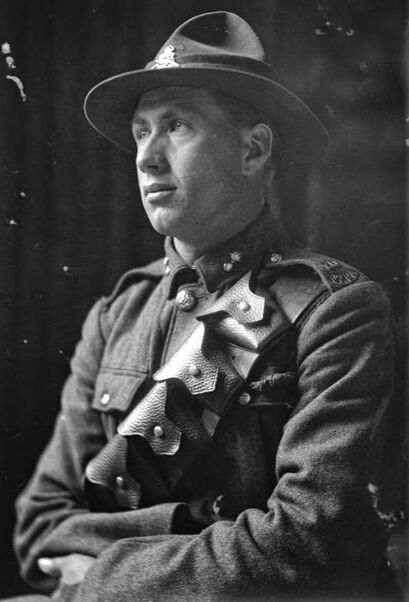
The 18th Reinforcements left NZ on the 14th & 16th of Oct 1916.
- The 18th Draft contained 1 Officers for the NZFA.
Vessels used from Wellington: Willochra and Tofua via Cape Good Hope - to Devonport - 77 days duration.
The 19th Reinforcements left NZ on the 15th of Nov 1916.
- The 19th Draft contained 1 Officers and 2 Other Ranks of the NZFA.
Vessels used from Wellington: Maunganui and Tahiti via Cape Good Hope - to Devonport - 74 days duration.
2nd Part of the 20th Reinforcements left NZ on the 30th of Dec 1916 & 2nd of Jan 1917.
- The 20th Draft contained 2 Officers and 108 Other Ranks to the NZFA.
Vessels used from Wellington: Port Lyttelton, Athenic and Opawa via Cape Good Hope - to Plymouth - 87 days duration.
- Opposite: A unamed image of a 20th New Zealand Field Artillery Reinforcement. He wears a NZ Artillery Cap badge to his Lemon Squeezer on the colours of a Blue/Red/Blue puggaree of the New Zealand Artillery.
On his shoulder boards is his reinforcement number of "20", over a curved "N.Z.F.A" or New Zealand Field Artillery shoulder title.
His Collar badges are the flaming grenade collar, used by the Corps, as well as the NZ Corps of Signals and the New Zealand Engineers (Auckland Libraries Heritage Collections 1142-D043).
The 21st Reinforcements left NZ on the 19th & 21st of Jan 1917.
- The 21st Draft contained 2 Officers and 107 Other Ranks of the NZFA.
Vessels used from Wellington: Waitemata & Ulmaroa via Cape Good Hope - to Plymouth - 68 days duration.
- The 18th Draft contained 1 Officers for the NZFA.
Vessels used from Wellington: Willochra and Tofua via Cape Good Hope - to Devonport - 77 days duration.
The 19th Reinforcements left NZ on the 15th of Nov 1916.
- The 19th Draft contained 1 Officers and 2 Other Ranks of the NZFA.
Vessels used from Wellington: Maunganui and Tahiti via Cape Good Hope - to Devonport - 74 days duration.
2nd Part of the 20th Reinforcements left NZ on the 30th of Dec 1916 & 2nd of Jan 1917.
- The 20th Draft contained 2 Officers and 108 Other Ranks to the NZFA.
Vessels used from Wellington: Port Lyttelton, Athenic and Opawa via Cape Good Hope - to Plymouth - 87 days duration.
- Opposite: A unamed image of a 20th New Zealand Field Artillery Reinforcement. He wears a NZ Artillery Cap badge to his Lemon Squeezer on the colours of a Blue/Red/Blue puggaree of the New Zealand Artillery.
On his shoulder boards is his reinforcement number of "20", over a curved "N.Z.F.A" or New Zealand Field Artillery shoulder title.
His Collar badges are the flaming grenade collar, used by the Corps, as well as the NZ Corps of Signals and the New Zealand Engineers (Auckland Libraries Heritage Collections 1142-D043).
The 21st Reinforcements left NZ on the 19th & 21st of Jan 1917.
- The 21st Draft contained 2 Officers and 107 Other Ranks of the NZFA.
Vessels used from Wellington: Waitemata & Ulmaroa via Cape Good Hope - to Plymouth - 68 days duration.
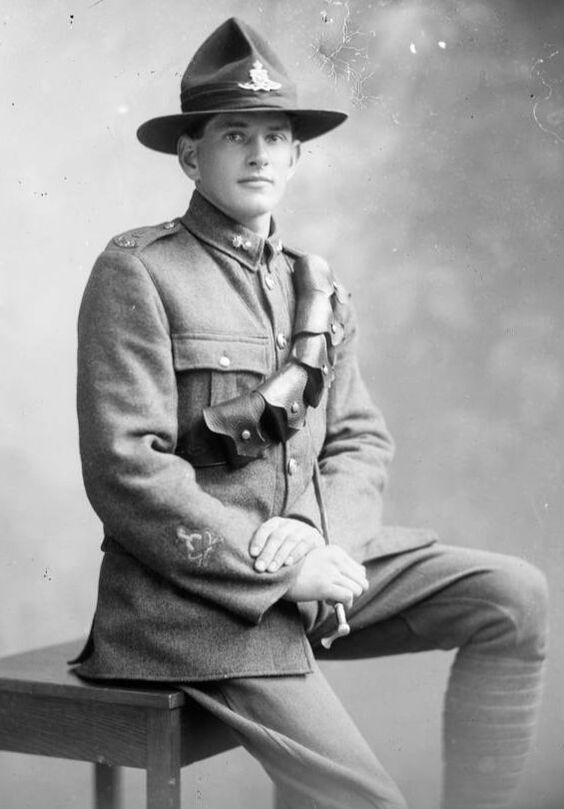
The 22nd Reinforcements left NZ on the 13th & 16th of Feb 1917.
- They 22nd Draft contained 2 Officers and 107 Other Ranks of the NZFA.
Vessels used from Wellington: Aparima, Mokoia and Navua via Cape Good Hope - to Devonport - 72 days duration.
- Opposite: A possible 22nd New Zealand Field Artillery Reinforcement. NZA Cap badge to lemon squeezer with NZ Artillery puggaree. He has a flaming grenade collar badge worn by the NZFA (NZE and NZCS also).
To his shoulder boards is a reinforcement number. I think its "22". Below is a curved "NZFA" shoulder title.
Note his sleeve badge, which is a Military Skill in Driving Horses proficiency trade badge.
2nd Part of the 23rd Reinforcements left NZ on the 3rd of April 1917.
- The 23rd Draft contained 2 Officers and 107 Other Ranks of the NZFA.
Vessels used from Wellington: Ruapehu and Corinthic via Cape Horn & Cape Town - to London - 70 days duration.
2nd Part of the 24th Reinforcements left NZ on the 26th of April 1917.
- The 24th Draft contained 2 Officers and 107 Other Ranks of the NZFA.
Vessel used from Wellington:
- Devon via Cape Horn & Cape Town - to Plymouth - 80 days duration
- Pakeha via Cape Good Hope - to Devonport - 80 days duration
The 25th Reinforcements left NZ on the 26th of April 1917.
- The 25th Draft contained 2 Officers and 107 Other Ranks of the NZFA.
Vessels used from Wellington: Tofua & Turakina via Cape Good Hope - to Plymouth - 85 days duration.
- They 22nd Draft contained 2 Officers and 107 Other Ranks of the NZFA.
Vessels used from Wellington: Aparima, Mokoia and Navua via Cape Good Hope - to Devonport - 72 days duration.
- Opposite: A possible 22nd New Zealand Field Artillery Reinforcement. NZA Cap badge to lemon squeezer with NZ Artillery puggaree. He has a flaming grenade collar badge worn by the NZFA (NZE and NZCS also).
To his shoulder boards is a reinforcement number. I think its "22". Below is a curved "NZFA" shoulder title.
Note his sleeve badge, which is a Military Skill in Driving Horses proficiency trade badge.
2nd Part of the 23rd Reinforcements left NZ on the 3rd of April 1917.
- The 23rd Draft contained 2 Officers and 107 Other Ranks of the NZFA.
Vessels used from Wellington: Ruapehu and Corinthic via Cape Horn & Cape Town - to London - 70 days duration.
2nd Part of the 24th Reinforcements left NZ on the 26th of April 1917.
- The 24th Draft contained 2 Officers and 107 Other Ranks of the NZFA.
Vessel used from Wellington:
- Devon via Cape Horn & Cape Town - to Plymouth - 80 days duration
- Pakeha via Cape Good Hope - to Devonport - 80 days duration
The 25th Reinforcements left NZ on the 26th of April 1917.
- The 25th Draft contained 2 Officers and 107 Other Ranks of the NZFA.
Vessels used from Wellington: Tofua & Turakina via Cape Good Hope - to Plymouth - 85 days duration.
2nd Part of the 26th with part of the 27th Reinforcements left NZ on the 12th of June 1917.
- The Draft contained 4 Officers and 214 Other Ranks of the NZFA.
Vessels used from Wellington:
- Willochra via Cape Good Hope - to Devonport - 66 days duration.
- Maunganui via Cape Good Hope - to Plymouth - 66 days duration.
- Tahiti via Cape Good Hope - to Plymouth - 66 days duration.
1st Part of the 28th Reinforcements left NZ on the 14th of July 1917.
- The Draft contain 2 Officers and 107 Other Ranks of the NZFA.
Vessels used from Wellington: Waitemata & Ulimaroa via Cape Good Hope - to Liverpool - 67 days duration.
1st Part of the 29th Reinforcements left NZ on the 13th & 15th of Aug 1917.
- The Drafts contained 2 Officers and 107 Other Ranks of the NZFA.
Vessels used from Wellington: Mokoia & Ruahine via Panama - to Glasgow - 50 days duration.
- The Draft contained 4 Officers and 214 Other Ranks of the NZFA.
Vessels used from Wellington:
- Willochra via Cape Good Hope - to Devonport - 66 days duration.
- Maunganui via Cape Good Hope - to Plymouth - 66 days duration.
- Tahiti via Cape Good Hope - to Plymouth - 66 days duration.
1st Part of the 28th Reinforcements left NZ on the 14th of July 1917.
- The Draft contain 2 Officers and 107 Other Ranks of the NZFA.
Vessels used from Wellington: Waitemata & Ulimaroa via Cape Good Hope - to Liverpool - 67 days duration.
1st Part of the 29th Reinforcements left NZ on the 13th & 15th of Aug 1917.
- The Drafts contained 2 Officers and 107 Other Ranks of the NZFA.
Vessels used from Wellington: Mokoia & Ruahine via Panama - to Glasgow - 50 days duration.
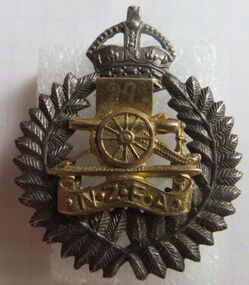
- Opposite: A Gold and Silver Sweethearts badge to the 29th New Zealand Field Artillery Reinforcement Draft. Marked "Stg. Silver." to back of frame, and "9ct" to back of "N.Z.F.A." banner. A brooch fitting also to back. Note the plaque to top, which has been engraved with the draft number "29".
The 31st & 32nd Reinforcements left NZ on the 17th & 22nd of Nov 1917.
- The combined Draft contained 3 Officers and 107 Other Ranks of the NZFA.
Vessels used from Wellington: Willochra, Managanui & Tahiti via Panama - to Liverpool - 49 days duration.
The 34th Reinforcements left NZ on the 8th of Feb 1918.
- The Draft contained 3 Officers and 82 Other Ranks of the NZFA.
Vessels used from Wellington: Ulimarua via Panama - to Plymouth - 49 days duration.
The 36th Reinforcements - left NZ on the 23rd of Apr & 2nd of May 1918. It contained the 28th Artillery Reinforcements.
- The Draft contained 3 Officers and 214 Other Ranks of the NZFA.
Vessels used from Wellington: Willochra, Ormonde & Duchess of Argylle to Suez - 39 days duration. Then to Taranto, Cherbourg and onto Southampton.
The 37th Reinforcements - 1st part - left NZ on the 9th of May 1918.
- The Draft contained 1 Officers and 107 Other Ranks of the NZFA.
Vessels used from Wellington: Maunganui via Panama - to Liverpool - 55 days duration.
The 40th Reinforcements - left NZ on the 10th of July 1918.
- The Draft contained 2 Officers and 107 Other Ranks of the NZFA.
Vessels used from Wellington: Tahiti via Cape Good Hope - to Plymouth - 64 days duration.
The 41st Reinforcements - left NZ on the 28th of July 1918.
- The Draft contained 2 Officers of the NZFA.
Vessels used from Wellington: Ulimaroa via Cape Good Hope - to London - 69 days duration.
The 43rd Reinforcements - 1st Draft - Ruahine - left NZ on the 18th of Aug 1918.
- The Draft consisted of 2 Officers and 109 Other Ranks of the NZFA.
Vessels used from Wellington: Ruahine via Cape Good Hope - to Tilbury - 73 days duration.
The 43rd Reinforcements - 2nd Draft - Matatua - left NZ on the 3rd of Oct 1918.
- The Draft consisted of 3 Officers and 109 Other Ranks of the NZFA.
Vessels used from Wellington: Matatua via Cape Good Hope - to London - 67 days duration.
132 Officers and 5,441 Other Ranks were sent overseas during WW1 to the NZFA.
6 Officers and 521 Other Ranks were still training in New Zealand on the 12th of November 1918.
The 31st & 32nd Reinforcements left NZ on the 17th & 22nd of Nov 1917.
- The combined Draft contained 3 Officers and 107 Other Ranks of the NZFA.
Vessels used from Wellington: Willochra, Managanui & Tahiti via Panama - to Liverpool - 49 days duration.
The 34th Reinforcements left NZ on the 8th of Feb 1918.
- The Draft contained 3 Officers and 82 Other Ranks of the NZFA.
Vessels used from Wellington: Ulimarua via Panama - to Plymouth - 49 days duration.
The 36th Reinforcements - left NZ on the 23rd of Apr & 2nd of May 1918. It contained the 28th Artillery Reinforcements.
- The Draft contained 3 Officers and 214 Other Ranks of the NZFA.
Vessels used from Wellington: Willochra, Ormonde & Duchess of Argylle to Suez - 39 days duration. Then to Taranto, Cherbourg and onto Southampton.
The 37th Reinforcements - 1st part - left NZ on the 9th of May 1918.
- The Draft contained 1 Officers and 107 Other Ranks of the NZFA.
Vessels used from Wellington: Maunganui via Panama - to Liverpool - 55 days duration.
The 40th Reinforcements - left NZ on the 10th of July 1918.
- The Draft contained 2 Officers and 107 Other Ranks of the NZFA.
Vessels used from Wellington: Tahiti via Cape Good Hope - to Plymouth - 64 days duration.
The 41st Reinforcements - left NZ on the 28th of July 1918.
- The Draft contained 2 Officers of the NZFA.
Vessels used from Wellington: Ulimaroa via Cape Good Hope - to London - 69 days duration.
The 43rd Reinforcements - 1st Draft - Ruahine - left NZ on the 18th of Aug 1918.
- The Draft consisted of 2 Officers and 109 Other Ranks of the NZFA.
Vessels used from Wellington: Ruahine via Cape Good Hope - to Tilbury - 73 days duration.
The 43rd Reinforcements - 2nd Draft - Matatua - left NZ on the 3rd of Oct 1918.
- The Draft consisted of 3 Officers and 109 Other Ranks of the NZFA.
Vessels used from Wellington: Matatua via Cape Good Hope - to London - 67 days duration.
132 Officers and 5,441 Other Ranks were sent overseas during WW1 to the NZFA.
6 Officers and 521 Other Ranks were still training in New Zealand on the 12th of November 1918.
NZ Army Chaplain Reinforcements
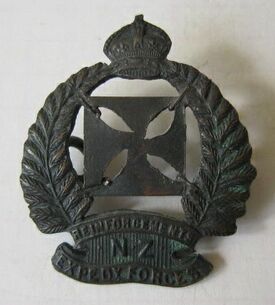
The following is a unverified badge to the New Zealand Chaplains Department. Certainly the New Zealand Army had Chaplains presents at the Reinforcement training camps during WW1, just as there were Chaplains serving overseas with the NZEF in France, the UK and Middle East. Just need to find pictorial evidence that this badge was worn. Maybe just made for the collectors market at the time.
- Opposite: A scarce collar badge to a New Zealand Chaplain Department associated with the WW1 Reinforcement drafts. I have seeing a couple of these collars over the years. This badge is in darkened copper, 2 piece, with a hand-cut cross added to center.
- Opposite: A scarce collar badge to a New Zealand Chaplain Department associated with the WW1 Reinforcement drafts. I have seeing a couple of these collars over the years. This badge is in darkened copper, 2 piece, with a hand-cut cross added to center.
New Zealand Dental Corps Reinforcements
The New Zealand Dental Service Corps formed on the 7th of November 1915 from Officers and Men who were part of the New Zealand Medical Corps.
It was designated the New Zealand Dental Corps on the 24th of Feb 1916.
As part of the Main body of the NZEF, which left in October 1914, 10 Dental Surgeons (unattached) were recorded as leaving with them. Then over the period of the conflict, Officers and men would be sent in ones and two's when needed as follows:
2 Officer as part of the 2nd Reinforcements left New Zealand on the 14th Dec 1914
1 Officer and 1 Other Ranks as part of the 9th Reinforcements left New Zealand on the 8th Jan 1916
1 Officer and 1 Other Ranks as part of the ship which took the 3rd and 4th Batt of the NZRB left New Zealand on the 7th Feb 1916
1 Officer and 1 Other Ranks as part of the 11th Reinforcements left New Zealand on the 2nd April 1916
3 Officer and 3 Other Ranks as part of the 22nd Reinforcements left New Zealand on the 13th & 16th Feb 1917
1 Officer and 1 Other Ranks as part of the 1st Portion of the 23rd Reinforcements left New Zealand on the 14th Mar 1917
1 Officer and 1 Other Ranks as part of the 2nd Portion of the 23rd Reinforcements left New Zealand on the 3rd April 1917
1 Officer and 1 Other Ranks as part of the 1st Portion of the 24th Reinforcements left New Zealand on the 6th April 1917
1 Officer and 1 Other Ranks as part of the 2nd Portion of the 24th Reinforcements left New Zealand on the 26th April 1917
2 Officer and 2 Other Ranks as part of the 1st Portion of the 25th Reinforcements left New Zealand on the 26th April 1917
1 Officer and 1 Other Ranks as part of the 1st Portion of the 26th Reinforcements left New Zealand on the 9th June 1917
2 Officer and 2 Other Ranks as part of the 2nd Portion of the 26th and 1st portion of the 27th Reinforcements left New Zealand on the 12th June 1917
2 Officer and 2 Other Ranks as part of the 2nd Portion of the 27th and 1st portion of the 28th Reinforcements left New Zealand on the 16th July 1917
1 Officer and 1 Other Ranks as part of the 2nd Portion of the 28th Reinforcements left New Zealand on the 26th July 1917
2 Officer and 2 Other Ranks as part of the 1st Portion of the 29th Reinforcements left New Zealand on the 13th and 15th Aug 1917
2 Officer and 2 Other Ranks as part of the 2nd Portion of the 29th and 30th Reinforcements left New Zealand on the 13th Oct 1917
3 Officer as part of the 31st and 32nd Reinforcements left New Zealand on the 17th and 22nd Nov 1917
2 Officer as part of the 34th Reinforcements left New Zealand on the 8th Feb 1918
2 Officer as part of the 35th Reinforcements left New Zealand on the 3rd Mar 1918
1 Officer as part of the 36th inf and 37th MR Reinforcements left New Zealand on the 23rd April and 2nd May 1918
1 Officer as part of the 37th Reinforcements left New Zealand on the 9th May 1918
Total sent with the NZEF overseas were 43 Officers (Dentists) and 22 other ranks as of the 12 of Nov 1918...
5 Officers were still in New Zealand, training at the time on the 12th of Nov 1918
These members of the NZDC were attached directly with the NZMC and the NZ Field Ambulances in the conflict zones.
In New Zealand, at the training camps, there were even larger set-ups, example with Trenham in 1917, they had NZDC staff consist of 18 Officers and 63 NCO's and men.
It was designated the New Zealand Dental Corps on the 24th of Feb 1916.
As part of the Main body of the NZEF, which left in October 1914, 10 Dental Surgeons (unattached) were recorded as leaving with them. Then over the period of the conflict, Officers and men would be sent in ones and two's when needed as follows:
2 Officer as part of the 2nd Reinforcements left New Zealand on the 14th Dec 1914
1 Officer and 1 Other Ranks as part of the 9th Reinforcements left New Zealand on the 8th Jan 1916
1 Officer and 1 Other Ranks as part of the ship which took the 3rd and 4th Batt of the NZRB left New Zealand on the 7th Feb 1916
1 Officer and 1 Other Ranks as part of the 11th Reinforcements left New Zealand on the 2nd April 1916
3 Officer and 3 Other Ranks as part of the 22nd Reinforcements left New Zealand on the 13th & 16th Feb 1917
1 Officer and 1 Other Ranks as part of the 1st Portion of the 23rd Reinforcements left New Zealand on the 14th Mar 1917
1 Officer and 1 Other Ranks as part of the 2nd Portion of the 23rd Reinforcements left New Zealand on the 3rd April 1917
1 Officer and 1 Other Ranks as part of the 1st Portion of the 24th Reinforcements left New Zealand on the 6th April 1917
1 Officer and 1 Other Ranks as part of the 2nd Portion of the 24th Reinforcements left New Zealand on the 26th April 1917
2 Officer and 2 Other Ranks as part of the 1st Portion of the 25th Reinforcements left New Zealand on the 26th April 1917
1 Officer and 1 Other Ranks as part of the 1st Portion of the 26th Reinforcements left New Zealand on the 9th June 1917
2 Officer and 2 Other Ranks as part of the 2nd Portion of the 26th and 1st portion of the 27th Reinforcements left New Zealand on the 12th June 1917
2 Officer and 2 Other Ranks as part of the 2nd Portion of the 27th and 1st portion of the 28th Reinforcements left New Zealand on the 16th July 1917
1 Officer and 1 Other Ranks as part of the 2nd Portion of the 28th Reinforcements left New Zealand on the 26th July 1917
2 Officer and 2 Other Ranks as part of the 1st Portion of the 29th Reinforcements left New Zealand on the 13th and 15th Aug 1917
2 Officer and 2 Other Ranks as part of the 2nd Portion of the 29th and 30th Reinforcements left New Zealand on the 13th Oct 1917
3 Officer as part of the 31st and 32nd Reinforcements left New Zealand on the 17th and 22nd Nov 1917
2 Officer as part of the 34th Reinforcements left New Zealand on the 8th Feb 1918
2 Officer as part of the 35th Reinforcements left New Zealand on the 3rd Mar 1918
1 Officer as part of the 36th inf and 37th MR Reinforcements left New Zealand on the 23rd April and 2nd May 1918
1 Officer as part of the 37th Reinforcements left New Zealand on the 9th May 1918
Total sent with the NZEF overseas were 43 Officers (Dentists) and 22 other ranks as of the 12 of Nov 1918...
5 Officers were still in New Zealand, training at the time on the 12th of Nov 1918
These members of the NZDC were attached directly with the NZMC and the NZ Field Ambulances in the conflict zones.
In New Zealand, at the training camps, there were even larger set-ups, example with Trenham in 1917, they had NZDC staff consist of 18 Officers and 63 NCO's and men.
